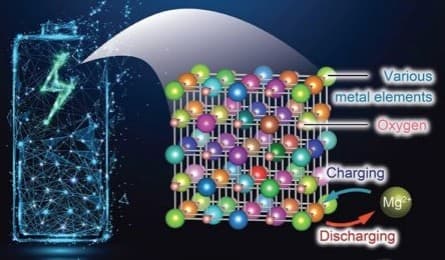Tohoku University researchers have made a groundbreaking advancement in battery technology, developing a novel cathode material for rechargeable magnesium batteries that enables efficient charging and discharging even at low temperatures.
Details of the findings were published in the Journal of Materials Chemistry A.
This innovative material, leveraging an enhanced rock-salt structure, promises to usher in a new era of battery energy storage solutions that are more affordable, safer, and higher in capacity.

Unleashing Disordered Rocksalt Oxides as Cathodes for Rechargeable Magnesium Batteries. Image Credit: Tohoku University Institute for Materials Research. Click here to see the largest image at the press release page.
The study showcases a considerable improvement in magnesium (Mg) diffusion within a rock-salt structure, a critical advancement since the denseness of atoms in this configuration had previously impeded Mg migration.
By introducing a strategic mixture of seven different metallic elements, the research team created a crystal structure abundant in stable cation vacancies, facilitating easier Mg insertion and extraction.
This represents the first utilization of rocksalt oxide as a cathode material for RMBs.
The high-entropy strategy employed by the researchers allowed the cation defects to activate the rocksalt oxide cathode.
The development also addresses a key limitation of RMBs – the difficulty of Mg transport within solid materials.
Until now, high temperatures were necessary to enhance Mg mobility in conventional cathode materials, such as those with a spinel structure.
However, the material unveiled by Tohoku University researchers operates efficiently at just 90°C, demonstrating a significant reduction in the required operating temperature.
Tomoya Kawaguchi, a professor at Tohoku University’s Institute for Materials Research (IMR), notes the broader implications of the study.
The professor said, “Lithium is scarce and unevenly distributed, whereas magnesium is abundantly available, offering a more sustainable and cost-effective alternative for lithium-ion batteries. Magnesium batteries, featuring the newly developed cathode material, are poised to play a pivotal role in various applications, including grid storage, electric vehicles, and portable electronic devices, contributing to the global shift towards renewable energy and reduced carbon footprints.”
Kawaguchi collaborated with Tetsu Ichitsubo, also a professor at IMR, who states, “By harnessing the intrinsic benefits of magnesium and overcoming previous material limitations, this research paves the way for the next generation of batteries, promising significant impacts on technology, the environment, and society.”
Ultimately, the breakthrough is a major step forward in the quest for efficient, eco-friendly energy storage solutions.
**
The headline is almost misleading. The new technology offered is still running at 90ºC, somewhat cooler than boiling water.
Yet, this is a considerable improvement for a battery chemistry with lots of possibility. And this research shows there is reason think this magnesium tech has enough going for it to stay in the research game.
There is cause to think the tech could get way cooler operating temps. It could be way less expensive. Lots of capacity potential. There is economic and political pressure to keep the hunt alive.
However, it’s a long way from running your EV on a cold morning.
By Brian Westenhaus via New Energy and Fuel
More Top Reads From Oilprice.com:
- Iran’s Response To Israel’s Strike Was Pure Political Theater
- Oil Prices Settle Near $90 Despite Rising Geopolitical Risk
- Strike Threatens To Halt Production at Key UK Steel Plant


















